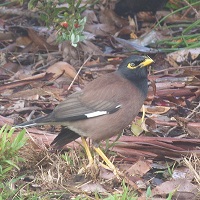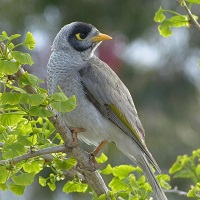Trapping Indian mynas
Buy and collect an Indian Myna trap
You can buy a hand-made pee gee trap from us for $60 each. Each trap includes a perch and two dishes for food and water.
Conditions
By buying a trap through our program, you agree:
- to comply with our trapping program terms and conditions. Any birds you trap must be euthanised (put to sleep) humanely.
- to complete the trapping record sheet and return it to us by email or post.
How to pay for and collect the trap
Pay for and collect a trap at our Customer Service Centre, 20 Siding Avenue, Officer during business hours.
Please bring a signed copy of the terms and conditions. This must be submitted to Customer Service at the time of purchasing your trap.
How to use the trap
Trapping tips
- Do not approach the trap in daylight. Indian mynas are intelligent and suspicious birds and learn quickly to avoid danger through their own experience and watching and listening to others of their kind.
- Trapping location is important. Set the trap close to where birds already feed, or where birds overlook from vantage points such as powerlines or trees.
- Place the trap where there is minimal traffic from people and animals, such as behind a shed or carport.
- The best bait for Indian mynas is dry red coloured cat food. You can also try dried white bread, pet animal pellets or leftovers. Try a variety of foods until you are successful.
- Do not use meat as it will smell and attract rats.
- Do not use chicken feed, grains or seeds of any sort. These will attract native birds and non-target species. Some birds eat only seeds, but Indian mynas will eat anything. This is why their spread and displacement of other bird species has been so successful.
- Place food on a white plate, or the white inside cap of a large jar or container.
- For the first few days put a small amount of loose feed outside the funnel entrances to attract Indian mynas to the trap area. Also place food in the tunnel, and inside the feeding chamber.
Locals vets who will put trapped birds to sleep
|
Veterinary clinic |
Address |
Phone |
Fee |
|---|---|---|---|
|
Avonsleigh Vet Clinic |
441 Belgrave–Gembrook Road, Avonsleigh |
5968 3957 |
Free; ask for John Hamilton |
|
Bunyip Veterinary Clinic |
1312 Nar Nar Goon–Longwarry Road, Bunyip |
5629 5309 |
$2–$5 per bird |
|
Koo Wee Rup Vet Clinic |
272 Rossiter Road, Koo Wee Rup |
5997 3300 |
Free to $5 depending on number of birds |
|
Racecourse Road Veterinary Clinic |
86 Racecourse Road, Pakenham |
5941 5994 |
Free |
Why Indian Mynas are a problem
Originally introduced to control insects, Indian mynas are a recognised invasive alien species. They are aggressive and compete with native animals for space. They force other birds and small mammals out of their own nests and tree hollows, and even throw other bird’s eggs and chicks out of their nests.
Indian mynas build large messy nests in roofs from sticks and any available rubbish they find, which can create fire risks in buildings. The accumulated droppings and mites from nests in house roofs are a breeding ground for disease, and inhaled mites can cause asthma and hay fever. They also spread rubbish about when they forage in open rubbish bins, creating a public health risk.
How to reduce the number of mynas in your garden
- Do not feed Indian mynas and clear away food scraps when eating outside.
- Feed pets indoors, or throw away leftover food after they finish eating.
- Feed stock only as much as they need, cover up feed bins and clean up spills.
- Block holes in the roof and eaves to prevent Indian mynas creating a nest.
- Planting more shrubs may reduce their presence, as they like open areas which they can monitor and are less common in dense shrubby areas. For help with plant selection use our online Indigenous Plant Guide.
- Avoid planting trees with dense foliage such as pencil pines, which mynas like to roost in at night. They are less likely roost in native trees.
Difference between Indian myna and Native noisy miner
The pest Indian myna has a chocolate brown coloured body, with black head and neck. It has a yellow beak, eye patch and legs, and has white wing patches that are visible during flight.

Photo by Suzanne Jones, Nature Share
The Native noisy miner has a pale grey chest and head, black eye patch, olive tinge strip along wings and flesh-coloured legs. As a native species they are protected and should not be trapped or injured in any way.

Photo by James Booth, Nature Share
